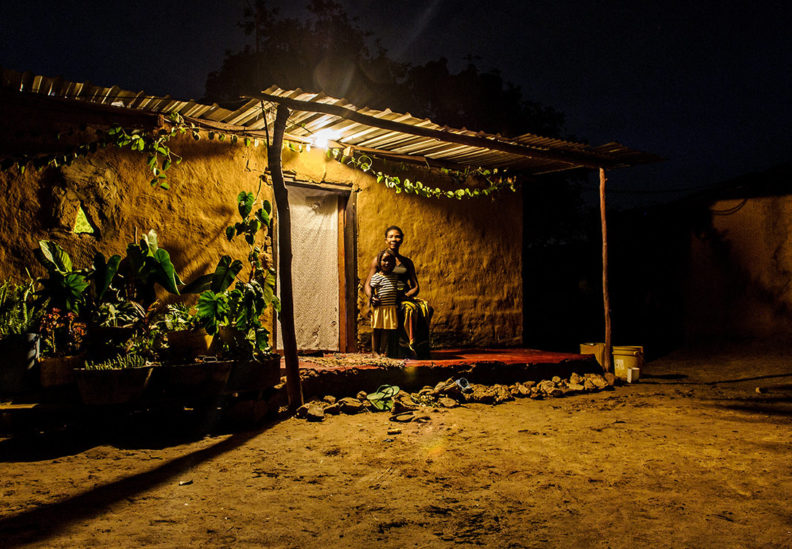“There is goodness here now.” Godfrey Miti, a resident of Ngwerere, on the outskirts of Zambia’s capital Lusaka, is optimistic about the future. He is standing under a lamp outside his mother’s house, and while for many a single lightbulb doesn’t mean much, in Ngwerere it represents progress, or “goodness”, as Godfrey calls it.
Ngwerere is mere minutes outside of Lusaka, but in terms of access to services, the community is a world away from the bustling city centre. Though the grid is not far away, there were no near-term plans to provide the area with electricity. The lack of modern energy has hindered development for the community at large. Today, however, the wait is over for many residents thanks to the completion of a solar-powered microgrid.
The system, developed by Standard Microgrid, is housed in a container and placed at the centre of the high-density community. It can serve up to 150 homes within 500 meters with affordable, reliable and clean energy. It has changed the way the residents of Ngwerere spend their time and their money.
“I have a television and bulbs connected. I used to use a different solar light and batteries, but this one is cheaper,” said father-of-eight Victor Zulu. Before the grid arrived, residents predominantly used candles for lighting. In a house like Victor’s, home to young children, candles are a hazard, so he looked for alternatives. While renewable energy solutions are not a new concept in Zambia, they are not always cheap or reliable. The microgrid, however, is an “efficient and smart” system that can be installed far quicker than traditional grids, provides power directly to houses, and sells electricity in innovative and customisable packages.
After placing the container and running the electrical cabling through the community, connections to customers’ houses are added, and the rest is up to agents and the customers. “Our service ends at the socket,” explains Standard Microgrid’s chief operating officer, Matthew Alcock. The company doesn’t sell appliances or lighting and doesn’t dictate – although does recommend – how customers use their energy. But despite this “hands off” approach and focus on building “plug and play”, one-size-fits-all systems that can transform communities within days, the grid and service are entirely people-centred.
“We wanted to create a utility in a box that we could roll out to communities and monitor off-site.” This has been achieved through a clever use of data. Each customer has an electrical box that communicates with the grid, telling it how much power is needed. The boxes are programmed by agents, who set up pre-paid energy plans according to the customers’ wishes. The customers can choose what time the power comes on and, guided by agents who submit this information through Standard Microgrid’s cell phone app, how much power to buy.
Agents are the primary point of contact for the customers. “We usually get a headman to suggest someone in the community – someone that residents see as reliable and trustworthy.” It is the agents who advise residents on how best to structure their plan and which appliances are the most efficient. While Alcock says the system is designed for the company to “set and forget”, the constant flow of data ensures the company knows exactly what is happening on the ground.
The data also allows Standard Microgrid to keep an eye on the microgrid’s batteries, monitor usage trends, and adjust pricing according to demand; the electricity is far cheaper during the day when demand is low. This has had a direct impact on businesses, which have benefited from cheap and reliable electricity. Within two months of the microgrid being installed, new businesses had already popped up, including one shop where young residents can pay to use gaming consoles, and small shops that can stay open much later.
Still, the small differences may have the greatest impact. “The lights are always on now,” says Godfrey. The streets are safer and inside, people are more active in the evenings.
“We’ve changed the way we live.” When they don’t spend their evenings studying, Godfrey’s children enjoy watching television with their grandmother and learning about current events. The arrival of the microgrid has lengthened people’s days, connected them to the world and improved their quality of life.
“People in the community are excited with what they can do now. We’re safer, and we have more hope.”
Standard Microgrid is a one of four awardees of the Beyond the Grid Fund for Zambia, an initiative of the Government of Sweden, together with Power Africa and in cooperation with Zambian partners. The fund seeks to rapidly scale-up energy access and build a market for energy services in Zambia. The goal of the fund is to bring modern energy services to one million Zambians by 2021. The Fund is managed by REEEP, the Renewable Energy and Energy Efficiency Partnership.
Photo: Cecelia and Godfrey Miti sit outside their home under lights powered by the solar microgrid. “This company has been good for the community. It’s nice to see development here and lights that are always on,” says Cecelia.
Photo Credit: Photo credit: Jason Mulikita for REEEP

